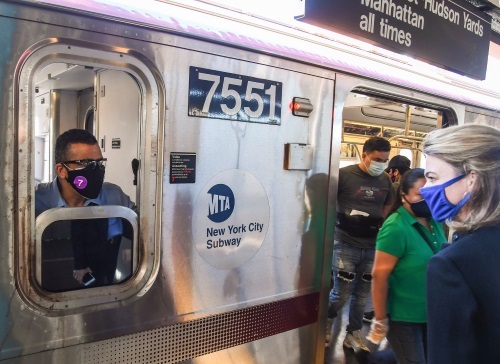The Centers for Disease Control began implementing provisions of President Biden’s Executive Order on Promoting COVID-19 Safety in Domestic and International Travel on February 2.
[Above photo by the Metropolitan Transportation Authority.]
As a result, the CDC mandated the wearing of masks by all travelers into, within, or out of the United States, on airplanes, ships, ferries, trains, subways, buses, taxis, and ride-shares.

The mask–wearing requirement also applies to travelers in U.S. transportation hubs such as airports and seaports; train, bus, and subway stations; and any other areas that provide transportation, the CDC said.
“Given how interconnected most transportation systems are across our nation and the world, when infected persons travel on public conveyances without wearing a mask and with others who are not wearing masks, the risk of interstate and international transmission can grow quickly,” explained Dr. Rochelle Walensky, CDC director, in a statement.
“Masks are most likely to reduce the spread of COVID-19 when they are widely and consistently used by all people in public settings,” she added.

The CDC originally issued a “strong recommendation” for public transportation passengers and transit operators alike to wear masks in order to prevent spread of the virus that causes COVID-19 in October 2020.
The agency now says its facemask mandate will “help prevent people who have COVID-19, including those who are pre-symptomatic or asymptomatic, from spreading the virus to others,” while also helping protect the wearer by reducing the chance they will breathe in respiratory droplets carrying the virus.
[Editor’s note: State departments of transportation have helped deploy a variety of strategies to help combat the spread of COVID-19 on transit systems over the course of 2020. The video below, for example, details how North Carolina Department of Transportation’s Integrated Mobility Division brought together representatives from state’s 98 transit systems to discuss COVID-19 response and recovery strategies, as well develop solutions to anticipated long-term challenges due to the viral pandemic.]
A report issued in October 2020 by the Sam Schwartz transportation-engineering firm on behalf of the American Public Transportation Association backs up the mask-wearing mandate where public transit use is concerned.
That report – entitled Public Transit and COVID-19 Pandemic: Global Research and Best Practices – found there is “no direct correlation” between use of urban public transit and transmission of the COVID-19 virus especially if riders wear masks.

“A review of studies from around the world indicate minimal risk from using public transit, especially where specific safeguards are in place, such as face coverings, well-functioning ventilation systems, and minimal talking by riders,” the report said.
Meanwhile, a test conducted by the U.S. Transportation Command in August 2020 indicated that the overall exposure risk from aerosolized pathogens such as COVID-19 “is very low” on Boeing 767-300 and 777-200 commercial aircraft – the airplane models the command uses to move Department of Defense personnel and their families.
That test – dubbed the Commercial Aircraft Cabin Aerosol Dispersion Test – revealed that the test aerosol released into the aircraft’s passenger compartment became “rapidly diluted” by the high air exchange rates observed in the airframes in less than six minutes. For comparison, a typical American home takes around 90 minutes to clear these types of particles from the air, U.S. Transcom said.



